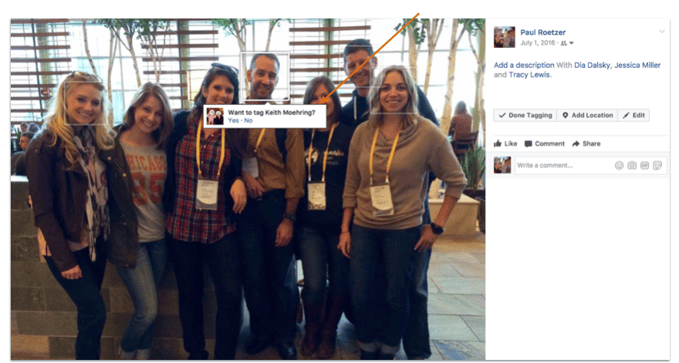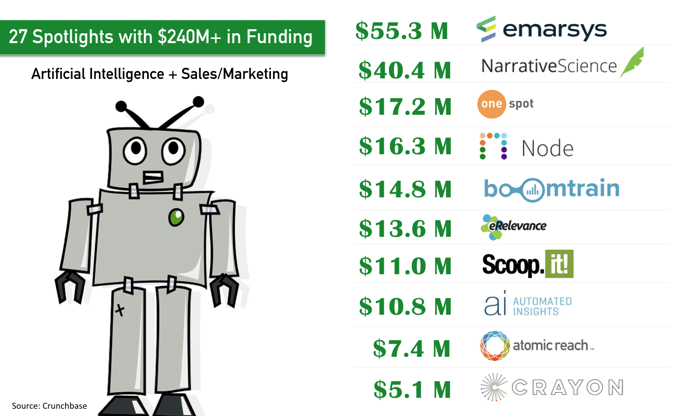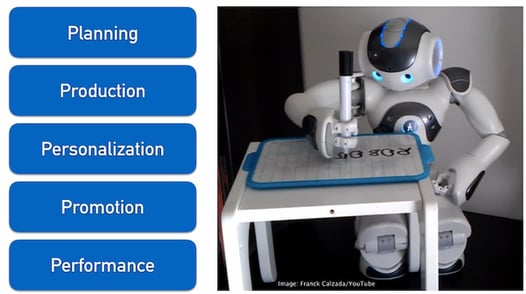“Can we automate content creation using artificial intelligence? More specifically, can we use machines to write blog posts at scale?”
These are the questions we sought to answer in spring 2015 when I launched an internal initiative named Project Copyscale at my content marketing agency, PR 20/20.
I’d had a growing fascination with artificial intelligence since IBM Watson won on Jeopardy! in 2011. I didn’t understand the underlying technology at the time, but when I read Automate This by Christopher Steiner in late 2012 I became convinced that artificial intelligence would transform marketing as we know it. It was only a matter of time.
“Some algorithms’ roots trace to the field of artificial intelligence. They may not be intelligent and self-aware like Hal 9000 (Heuristically programmed ALgorithmic computer), the machine from the movie 2001: A Space Odyssey (1968), but algorithms can evolve. They observe, experiment, and learn—all independently of their human creators. Using advanced computer science techniques such as machine learning and neural networking, algorithms can even create new and improved algorithms based on observed results.” — Christopher Steiner, Automated This (Penguin Group, 2012)
What Is Artificial Intelligence?
Ask 10 different experts to define AI, and you’ll likely get 10 different definitions. My favorite, in part because of its simplicity, is from Demis Hassibis, Co-Founder and CEO of Google DeepMind. Hassibis defines AI as, “the science of making machines smart.” These machines, in turn, enhance human knowledge and capabilities. (Yes, they sometimes will replace humans as well, but that’s a story for another time.)
Now, if you’re new to AI, even that basic definition is a bit abstract. Not to mention it doesn’t help us understand the difference between artificial intelligence and all the other AI-related terms we hear, such as machine learning, natural language processing, natural language generation, deep learning, neural networks, computer vision and facial recognition.
But, luckily, journalist and analyst John Koetsier has a handly little visual in his post, 2-minute explainer: AI vs. machine learning vs. deep learning, to help break it down for us. (Note, I’ve added the terms in blue for additional context.)

Basically, artificial intelligence is the umbrella term for the algorithms, technologies and techniques that make machines smarter, and give them superhuman capabilities.
From a marketing perspective, it’s easiest to understand by looking at specific challenges and use cases. For example, let’s take the case of an ebook.
When someone downloads an ebook, a marketer defines a set of rules that tells the machine what to do next (i.e. If visitor downloads ebook, then send three-part email). This set of rules is called an algorithm. And, in isolation, setting this single rule for a single download is very straightforward.
However, what if there are 10,000 downloads, across five personas, originating from multiple channels (social, organic, paid, direct) that require personalized emails and website experiences based on user history?
Humans are unable to conceive of the optimal set of instructions to guide the machine on how to personalize experiences at this scale. This is where artificial intelligence excels. It takes data-driven, complex tasks and makes them look easy.
But, artificial intelligence doesn’t stop at setting up the initial rules to maximize performance, it uses machine learning to constantly evolve its actions. In other words, it learns, it gets smarter, and it creates its own algorithms.
Now, imagine the potential if all the time-intensive tasks you complete and the data-driven decisions you make everyday as a marketer were intelligently automated.
And consider if that was only the beginning...
Artificial Intelligence Is Hiding in Plain Sight
You use artificial intelligence dozens, if not hundreds, of times everyday and you probably don’t even know it.
Facebook uses facial recognition to recommended who to tag in your photos.

Google uses natural language processing to enable voice search, and machine learning to surface related searches, and generate and prioritize search results.

Google also uses natural language processing, natural language generation and machine learning to recommend three-to-five word responses in the Gmail app and power Smart Reply, which predicts which word you'll want to type next.

Netflix uses machine learning to constantly adapt and personalize its movie and show recommendations, and manufacture shows based on subscriber viewing habits and preferences.

The Washington Post, which is owned by Jeff Bezos, CEO of Amazon, uses its Heliograf artificial intelligence storytelling system to write data-driven articles, its Knowledge Map to identify and surface contextual content, and its “Bandito” tool to drive engagement.

And, then, of course, there’s Amazon. Amazon has made massive investments in the use of AI to continuously optimize its personalization capabilities and enhance user experiences (i.e. make you buy more things).

These are just a few of the seemingly endless examples of how AI has become prevalent in the companies we use everyday as consumers.
In other words, your life is already machine-assisted, and your marketing will be too.
The Marketing Machine Age
We’ve profiled 27 companies since launching the Marketing Artificial Intelligence Institute in November 2016. Those organizations have combined funding north of $240 million, according to Crunchbase.

But, that’s just the tip of the iceberg.
We’re tracking more than 510 sales and marketing AI companies in Crunchbase with combined known funding in excess of $2.9 billion. Based on funding velocity through August 2017, these companies alone would be forecasted to take in more than $450 million in funding this year.
Despite the buzz and hype around artificial intelligence, and the funding velocity, what we’ve learned so far is that many AI solutions aren’t actually that “intelligent,” yet. In other words, these technologies are just scratching the surface of what their products will be able to do in the months and years ahead.
The accelerated funding helps these companies invest in the talent and technology needed to make their software smarter. And, even the most basic applications of AI can dramatically enhance marketers’ knowledge and capabilities.
So, how do you get started with AI? How do you determine the current and future potential for AI to improve, and eventually transform, your marketing program?
For that, we need a logical, use-case based framework.
The Need for a Marketing AI Framework
By summer 2016, my fleeting fascination with artificial intelligence had given way to a full-blown obsession. Fueled by my consumption of an online course on machine learning (which I mostly understood), hundreds of articles and reports, and a collection of related books—Automate This, The Master Algorithm, How to Create a Mind, The Singularity Is Near, Superintelligence, The Second Machine Age, The Pentagon’s Brain, and Keeping Up with the Quants—the narrative of how AI would impact marketing started to take shape in my mind.
When faced with telling complex stories, I’ve always found it best to start with an outline. In the case of artificial intelligence, I began working on an outline for a new book.
I wanted to take readers on a journey, from the origins of artificial intelligence to a future in which man and machine worked seamlessly to run personalized marketing campaigns of unprecedented complexity with unimaginable simplicity.
The challenge in creating the book outline was the middle part of the story. I realized I had no idea what marketers could do now with artificial intelligence.
I didn’t know which of the AI-powered tech startups were legit, and it was becoming increasingly difficult to cut through all the noise. Suddenly everyone was inserting “AI,” “machine learning,” and “deep learning” into their messaging, but it wasn’t clear how much more intelligent and efficient their software really was.
In addition, it started becoming increasingly apparent that intelligently automating marketing would require dozens of individual tools. That’s because AI is narrow in its capability and must be purpose-built to do one thing at a time. In other words, there is no marketing AI platform that neatly bundles everything up into a single monthly subscription.
While all the major players in marketing automation and CRM are aggressively building and buying AI capabilities, we’re still years away from an (artificially) intelligent marketing platform.
So, by fall 2016, I was left with an incomplete book outline. I knew the beginning, and the end, but I was missing the most important part: today. What do we do now?
The 5Ps of Marketing AI
In November 2016 we launched the Marketing Artificial Intelligence Institute and published our first Spotlight on the blog in which we ask the same eight questions of every company (see sample Spotlights for Emarsys, Narrative Science, Skyword, Node and OneSpot).
These eight questions were chosen to make AI more approachable and actionable for readers, but also to help us figure out the middle part of the story.
I wanted to hear directly from the entrepreneurs and engineers building AI tools what the use cases and limitations were, how they were using AI in their products, and what type of organizations were applying and benefiting from AI already.
The insights gained from this research led to the creation of a new framework to help visualize and organize the marketing AI technology landscape—the 5Ps of Marketing AI.

First presented during my Content Marketing World 2017 session on Machine-Assisted Narrative, it’s definitely a beta framework. It will evolve as the market shifts and as we develop a deeper understand of AI and its implications on the industry.
But, for now, hopefully it helps you better comprehend the vast potential of AI to enhance your capabilities as a marketer. Artificial intelligence tools exist or are being built for most of the use cases shown, and likely dozens more we’re not aware of or envisioning yet.
Planning: Build intelligent strategies.
- Determine goals.
- Construct buyer personas.
- Discover keywords and topic clusters.
- Analyze existing content for gaps and opportunities.
- Determine editorial calendar topics.
- Capture competitive intelligence.
- Segment contact databases.
- Identify companies and contacts most likely to convert.
- Predict conversion paths and points along the buyer journey.
- Predict churn.
- Prescribe marketing strategies and tactics.
- Allocate digital paid budget by channel and audience.
Production: Create intelligent content.
- Draft social media updates.
- Write data-driven content.
- Optimize content for search engines.
- Curate content.
- Develop ad copy and creative.
- Write email subject lines.
- Write nurturing/sales email workflows.
- Convert voice to text, and text to voice.
- Recognize, categorize and auto-tag images.
- Analyze (and score) text for grammar, sentiment, tone and style.
- Design websites.
Personalization: Power intelligent consumer experiences.
- Recommend highly targeted content.
- Deliver predictive product recommendations.
- Personalize content, offers and web experiences with images, text and CTAs.
- Engage users through bots and chat.
- Serve up contextual ads based on user history and look-a-like data.
- Answer voice and text questions.
- Deliver customized search results.
- Individualize and optimize email send time.
Promotion: Manage intelligent cross-channel and cross-device promotions.
- Adjust digital ad spend in real-time by channel and audience.
- Optimize cross-channel campaigns.
- Test headlines, landing pages, images and creative.
- Schedule social shares.
- Improve email deliverability.
- Deliver (re)targeted ads.
Performance: Turn data into intelligence.
- Score leads and continually adapt the lead scoring system.
- Monitor activities and outcomes.
- Discover insights from analytics.
- Forecast performance.
- Write performance reports.
The 5Ps framework is designed to broadly cover the entire marketing process, and help marketers identify gaps and seize opportunities to implement AI at every level of their operations. See the full Machine-Assisted Narrative deck on Slideshare for additional context and examples.
Moving Forward + The Marketer-to-Machine Scale
The five categories, and dozens of use cases, are at differing levels of maturity. I like to think of each use case on a marketer-to-machine (M2M) scale of what it enables:
- 1 = All humans, all the time (Note, this is where most traditional marketing software is today. Humans write the code that makes the software, and marketers write the rules/algorithms that determine what it does.)
- 2 = Minimal AI involvement
- 3 = About half human, half machine
- 4 = Predominantly AI driven
- 5 = Fully autonomous
Most marketing AI technology is in its infancy. This means that the products being built specifically to be more intelligent than traditional marketing software maybe get marketers to a 2 or 3 on the M2M scale.
There are lots of interesting products that show tons of promise, but the “smartest” ones with the best teams of highly desirable AI talent will likely be acquired and rolled up into the inevitable marketing AI platforms being built by Adobe, HubSpot, IBM, Oracle, Salesforce and others. This will bring its own set of challenges to early adopters of AI. (We’ll talk more about that in future posts.)
While in the near term (say three-to-five years) marketers will require a mash-up of AI tools to drive productivity, profitability and performance, in time, AI will be omnipresent in marketing software.
So, much like you use AI everyday in your personal life, you will benefit from AI everyday in your professional life and many times not even know you’re using it.
AI Can Be Your Competitive Advantage
I get asked all the time whether or not AI will replace marketers. The short answer is that it will largely enhance knowledge and capabilities, in the near term.
Individual activities, such as A/B testing of landing pages or short email replies, are close to reaching a 4 - 5 on the M2M scale, but, for the most part, many of the use cases highlighted are years away from self-running, self-improving autonomous systems.
So, for now, AI can be your competitive advantage. It can give you superpowers.
Start with a single use case that consumes a disproportionate amount of your time. Then, find an AI technology built to solve that exact problem.
To do that, check out our AI Score for Marketers tool. It'll help you explore and rate dozens of AI use cases, and get personalized recommendations for AI-powered vendors.
Paul Roetzer
Paul Roetzer is founder and CEO of Marketing AI Institute. He is the author of Marketing Artificial Intelligence (Matt Holt Books, 2022) The Marketing Performance Blueprint (Wiley, 2014) and The Marketing Agency Blueprint (Wiley, 2012); and creator of the Marketing AI Conference (MAICON).


